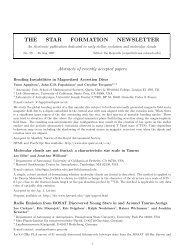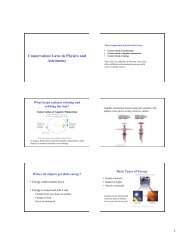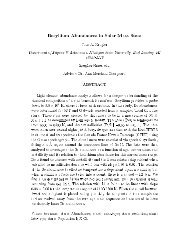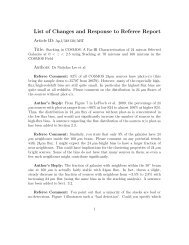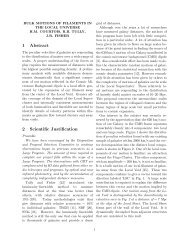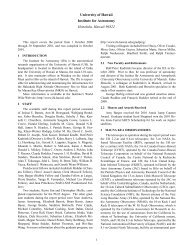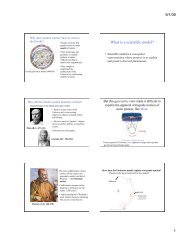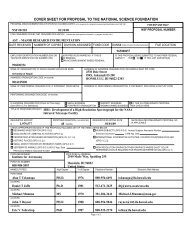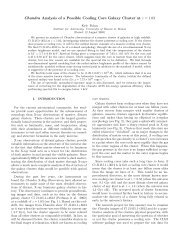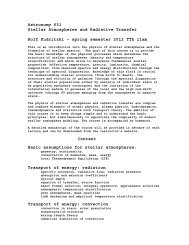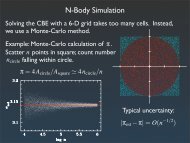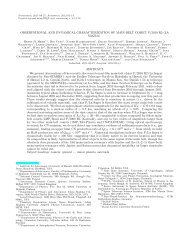University of Hawaii Institute for Astronomy Honolulu, Hawaii 96822
University of Hawaii Institute for Astronomy Honolulu, Hawaii 96822
University of Hawaii Institute for Astronomy Honolulu, Hawaii 96822
Create successful ePaper yourself
Turn your PDF publications into a flip-book with our unique Google optimized e-Paper software.
<strong>University</strong> <strong>of</strong> <strong>Hawaii</strong><br />
<strong>Institute</strong> <strong>for</strong> <strong>Astronomy</strong><br />
<strong>Honolulu</strong>, <strong>Hawaii</strong> <strong>96822</strong><br />
This report covers the period from 1 October 2003<br />
through 30 September 2004, and was compiled in October<br />
2004.<br />
1 INTRODUCTION<br />
The <strong>Institute</strong> <strong>for</strong> <strong>Astronomy</strong> (IfA) is the astronomical<br />
research organization <strong>of</strong> the <strong>University</strong> <strong>of</strong> <strong>Hawaii</strong> (UH). Its<br />
headquarters is located in <strong>Honolulu</strong> on the island <strong>of</strong> Oahu<br />
near the <strong>University</strong> <strong>of</strong> <strong>Hawaii</strong> at Manoa, the main UH campus.<br />
It also maintains <strong>of</strong>fices in Waiakoa on the island <strong>of</strong><br />
Maui, and in Hilo on the island <strong>of</strong> <strong>Hawaii</strong>. The IfA is responsible<br />
<strong>for</strong> administering and maintaining the infrastructure <strong>for</strong><br />
the Haleakala High Altitude Observatory Site on Maui and<br />
<strong>for</strong> Mauna Kea Observatories (MKO) on <strong>Hawaii</strong>.<br />
More in<strong>for</strong>mation is available at the <strong>Institute</strong>’s World<br />
Wide Web site: www.ifa.hawaii.edu/.<br />
2 STAFF<br />
The scientific staff during this report period consisted <strong>of</strong><br />
Joshua E. Barnes, Ann M. Boesgaard, Fabio Bresolin, Schelte<br />
J. Bus, Kenneth C. Chambers, Mark R. Chun, Paul H. Coleman,<br />
Antoinette Songaila Cowie, Lennox L. Cowie, Harald<br />
Ebeling, Christ Ftaclas, Donald N. B. Hall, James N. Heasley,<br />
J. Patrick Henry, George H. Herbig (emeritus), Klaus-Werner<br />
Hodapp, Esther M. Hu, Robert Jedicke, David C. Jewitt,<br />
Robert D. Joseph, Nick Kaiser, Rolf-Peter Kudritzki (director),<br />
Jeffrey R. Kuhn, Jing Li, Haosheng Lin, Michael Liu,<br />
Gerard A. Luppino, Eugene A. Magnier, Eduardo L. Martín,<br />
Robert A. McLaren, Karen J. Meech, Roberto H. Méndez,<br />
Donald L. Mickey, Tobias C. Owen, Andrew J. Pickles, John<br />
T. Rayner, Bo Reipurth, David B. Sanders, Theodore Simon,<br />
Alan Stockton, István Szapudi, David J. Tholen, Alan<br />
T. Tokunaga, Eric V. Tollestrup, John L. Tonry, R. Brent<br />
Tully, Richard J. Wainscoat, Jonathan P. Williams, and Gareth<br />
Wynn-Williams.<br />
Postdoctoral fellows included Hervé Aussel, Fabrizio<br />
Bernardi, Crystal Brogan (James Clerk Maxwell Fellow),<br />
Gang Chen, Gayoung Chon, Yanga R. Fernández (SIRTF Fellow),<br />
Pablo Fosalba, Tommy Grav, Lisa Kewley (Hubble Fellow),<br />
Jan Kleyna (Parrent Fellow), Andisheh Mahdavi (Chandra<br />
Fellow), Jun Pan, Jana Pittichová, Paul Price, Norbert<br />
Przybilla, Luca Rizzi, Thomas Stanke (Alexander v. Humboldt<br />
Fellow), and Miguel Urbaneja.<br />
James Armstrong, Brian Barris, Peter Capak, Michael<br />
Cushing, Catherine Garland, Catherine Ishida, and Scott<br />
Sheppard completed requirements <strong>for</strong> the Ph.D. degree.<br />
The other graduate students during the report period were<br />
Sean Andrews, Elizabeth Barrett, Sandrine Bottinelli, Li Hsin<br />
Chien, Michael Connelley, Scott Dahm, David Donovan,<br />
Luke Dundon, Trent Dupuy, Hai Fu, Ben Granett, David Harrington,<br />
Henry Hsieh, Yuko Kakazu, Jeyhan Kartaltepe, Dale<br />
Kocevski, Cheng-Jiun Ma, Rita Mann, Joseph Masiero, Elizabeth<br />
McGrath, Nicholas Moskovitz, Megan Novicki, Maria<br />
Pereira, Mark Pitts, Steve Rodney, Barry Rothberg, Scott<br />
Sheppard, Brian Stalder, Wei-Hao Wang, Kathryn Whitman,<br />
Mark Willman, and Bin Yang. For more in<strong>for</strong>mation about<br />
the graduate program, see www.ifa.hawaii.edu/gradprog/.<br />
Visiting colleagues included Amy Barger (<strong>University</strong><br />
<strong>of</strong> Wisconsin-Madison), Miwa Goto (Subaru Telescope),<br />
Masateru Ishiguro (The <strong>Institute</strong> <strong>of</strong> Space and Astronautical<br />
Science, Japan), Robert Lupton (Princeton), Nicholas Scoville<br />
(Caltech), Paula Skody (<strong>University</strong> <strong>of</strong> Washington), and<br />
Ana Maria Teodorescu (<strong>University</strong> <strong>of</strong> Rome).<br />
2.1 New Faculty<br />
The UH Astrobiology Lead Team (see sec. 8) added eight<br />
postdoctoral fellows, who arrived in June through September<br />
2004. Though most are not astronomers, all have been<br />
hired by the IfA. They are Andrew Boal (organic chemistry),<br />
Mark Brown (microbiology), Lysa Chizmadia (geochemistry),<br />
Audrey Delsanti (astronomy), Brian Glazer (marine biology/biochemistry),<br />
Nader Haghighipour (astronomy), Norbert<br />
Schorgh<strong>of</strong>er (astronomy), and Weijun Zheng (chemistry).<br />
2.2 Honors and Awards Received<br />
NASA awarded the NASA Public Service Medal to<br />
Robert Joseph. The citation, signed by the NASA Administrator<br />
Sean O’Keefe, reads, “For outstanding leadership while<br />
serving as Director, Infrared Telescope Facility, enabling extraordinary<br />
planetary science research and exceptional contributions<br />
to the NASA Solar System Exploration mission.”<br />
The Royal Society elected IfA astronomer Lennox Cowie<br />
a fellow <strong>of</strong> the society.<br />
The <strong>Hawaii</strong> chapter <strong>of</strong> Achievement Rewards <strong>for</strong> College<br />
Scientists (ARCS) selected graduate student Scott Dahm as<br />
the winner <strong>of</strong> both the 2004 Helen Jones Farrar ARCS Scholarship<br />
in astronomy and the ARCS Student <strong>of</strong> the Year award.<br />
In addition, IfA astronomer John Tonry was named ARCS<br />
Scientist <strong>of</strong> the Year.<br />
The <strong>University</strong> <strong>of</strong> <strong>Hawaii</strong> Board <strong>of</strong> Regents awarded<br />
Tonry a 2004 Regents Medal <strong>for</strong> Excellence in Research.<br />
NASA presented IfA Director Rolf Kudritzki with a<br />
certificate recognizing the IfA’s Lunar Ranging Experiment<br />
(LURE) <strong>for</strong> its “support and dedication to the NASA Satellite<br />
Laser Ranging (SLR) Program and the International Laser<br />
Ranging Service.”<br />
Kudritzki was elected chair <strong>of</strong> the Association <strong>of</strong> Universities<br />
<strong>for</strong> Research in <strong>Astronomy</strong> (AURA) board <strong>of</strong> directors<br />
<strong>for</strong> a one-year term, effective 1 July 2004.<br />
1
3 MAUNA KEA OBSERVATORIES<br />
The telescopes in operation during the report period were<br />
the UH 2.2-m and 0.6-m telescopes; the 3-m NASA Infrared<br />
Telescope Facility (IRTF), operated by the UH under<br />
a cooperative agreement with NASA; the 3.6-m Canada-<br />
France-<strong>Hawaii</strong> Telescope (CFHT), operated by the Canada-<br />
France-<strong>Hawaii</strong> Telescope Corporation on behalf <strong>of</strong> the National<br />
Research Council <strong>of</strong> Canada, the Centre National de la<br />
Recherche Scientifique <strong>of</strong> France, and UH; the 3.8-m United<br />
Kingdom Infrared Telescope (UKIRT), operated in <strong>Hawaii</strong> by<br />
the Joint <strong>Astronomy</strong> Centre (JAC) based in Hilo on behalf <strong>of</strong><br />
the Particle Physics and <strong>Astronomy</strong> Research Council <strong>of</strong> the<br />
United Kingdom; the 15-m James Clerk Maxwell Telescope<br />
(JCMT), a submillimeter telescope operated by the JAC on<br />
behalf <strong>of</strong> the United Kingdom, Canada, and the Netherlands;<br />
the 10.4-m Caltech Submillimeter Observatory (CSO), operated<br />
by the Cali<strong>for</strong>nia <strong>Institute</strong> <strong>of</strong> Technology <strong>for</strong> the National<br />
Science Foundation (NSF); the <strong>Hawaii</strong> antenna <strong>of</strong> the Very<br />
Long Baseline Array (VLBA), operated by the National Radio<br />
<strong>Astronomy</strong> Observatory (NRAO); the 10-m Keck I and<br />
Keck II telescopes <strong>of</strong> the W. M. Keck Observatory, which is<br />
operated by the Cali<strong>for</strong>nia Association <strong>for</strong> Research in <strong>Astronomy</strong><br />
<strong>for</strong> the use <strong>of</strong> astronomers from the Cali<strong>for</strong>nia <strong>Institute</strong><br />
<strong>of</strong> Technology, the <strong>University</strong> <strong>of</strong> Cali<strong>for</strong>nia system,<br />
NASA, and UH; the 8.3-m Subaru Telescope, operated by<br />
the National Astronomical Observatory <strong>of</strong> Japan (NAOJ); the<br />
8.1-m Frederick C. Gillett Gemini Telescope (Gemini North),<br />
operated by AURA on behalf <strong>of</strong> an international partnership<br />
that includes the United States, the United Kingdom, Canada,<br />
Argentina, Australia, Brazil, and Chile; and the Submillimeter<br />
Array (SMA), operated by the Smithsonian Astrophysical<br />
Observatory in collaboration with the <strong>Institute</strong> <strong>of</strong> <strong>Astronomy</strong><br />
and Astrophysics <strong>of</strong> the Academia Sinica <strong>of</strong> Taiwan. The<br />
SMA, which comprises eight 6-m antennae, was completed<br />
during the report period and was <strong>of</strong>ficially dedicated on 22<br />
November 2003.<br />
4 HALEAKALA OBSERVATORIES<br />
<strong>Astronomy</strong> facilities on the summit <strong>of</strong> Haleakala include<br />
the Mees Solar Observatory, which supports IfA solar<br />
scientists in data acquisition by running diverse observational<br />
programs with the Imaging Vector Magnetograph<br />
(IVM), Haleakala Stokes Polarimeter, Mees CCD Imaging<br />
Spectrograph (MCCD), Mees White Light Telescope, and<br />
Coronal Limb Imagers; SOLARC (Scatter Free Observatory<br />
<strong>for</strong> Limb Active Regions and Coronae), a 0.5-m <strong>of</strong>f-axis<br />
coronagraphic reflecting telescope; the Advanced Electro-<br />
Optical System (AEOS) Haleakala Atmospheric Characterization<br />
Project, which supports the AEOS telescope by providing<br />
comprehensive atmospheric characterization and timely<br />
prediction <strong>of</strong> inclement weather conditions at the observatory<br />
site; the Faulkes Telescope North (see sec. 9.3); and the 2-m<br />
Multicolor Active Galactic Nuclei Monitoring (MAGNUM)<br />
Telescope, which is a collaboration between the <strong>University</strong><br />
<strong>of</strong> Tokyo and UH. More in<strong>for</strong>mation about these projects can<br />
be found at www.ifa.hawaii.edu/haleakala/.<br />
LURE Observatory ceased operations and closed at the<br />
end <strong>of</strong> the contract period in June 2004. LURE Observatory<br />
had operated as a Lunar and Satellite Laser Ranging Station<br />
(LLR/SLR) since the early 1970s. Since its founding,<br />
NASA/Goddard Space Flight Center funded LURE Observatory<br />
with a series <strong>of</strong> five-year contracts. Un<strong>for</strong>tunately, severe<br />
budget cuts <strong>for</strong>ced NASA to drastically reduce support<br />
<strong>for</strong> LURE, and the IfA decided to not pursue a contract after<br />
the end <strong>of</strong> the 1999–2004 contract. The LURE site will be<br />
used by the prototype Pan-STARRS telescope (PS1) now in<br />
development (see sec. 6).<br />
In addition, the Air Force Research Laboratory operates<br />
the Maui Space Surveillance System (MSSS), a state<strong>of</strong>-the-art<br />
electro-optical facility combining operational satellite<br />
tracking facilities with a research and development facility.<br />
The MSSS houses the largest telescope in the Department<br />
<strong>of</strong> Defense, the 3.67-m Advanced Electro Optical System<br />
(AEOS), as well as several other telescopes ranging from<br />
0.4 m to 1.6 m.<br />
During the report period, in December 2003, Haleakala<br />
was selected by the National Solar Observatory and its partners<br />
as one <strong>of</strong> three possible sites <strong>for</strong> the 4-m Advanced Technology<br />
Solar Telescope (ATST).<br />
5 INSTRUMENTATION<br />
H ōk ūpa‘a-85, the curvature-sensing adaptive-optics system<br />
being built by the IfA <strong>for</strong> Gemini South, was essentially<br />
completed within the report period. Laboratory tests indicate<br />
that it should be capable <strong>of</strong> ∼80% Strehl ratios under normal<br />
seeing conditions at 2.2 µm.<br />
NSFCAM, a 1–5.5 µm camera with a 256 × 256 InSb<br />
array, is a NASA IRTF facility instrument. Work started in<br />
May 2004 to install a 2048 × 2048 array <strong>for</strong> use with the<br />
adaptive optics system.<br />
6 PAN-STARRS<br />
The Panoramic Survey Telescope and Rapid Response<br />
System (Pan-STARRS) project will create a wide-field imaging<br />
system with an innovative design. It is supported by a<br />
grant from the Air Force Research Laboratories. Kaiser is the<br />
principal investigator.<br />
Pan-STARRS will be composed <strong>of</strong> four 1.8-m telescopes<br />
observing the same region <strong>of</strong> sky simultaneously. Each telescope<br />
will have a 3 ◦ field <strong>of</strong> view and be equipped with a<br />
CCD focal plane mosaic with 10 9 pixels. The spatial sampling<br />
<strong>of</strong> the sky will be about 0.3 arcsec. In survey mode,<br />
e.g., searching <strong>for</strong> potential killer asteroids, Pan-STARRS<br />
will cover 6,000 deg 2 per night. The whole available sky as<br />
seen from <strong>Hawaii</strong> will be observed three times during the dark<br />
time in each lunation.<br />
Development <strong>of</strong> a prototype telescope, PS1, in the <strong>for</strong>mer<br />
LURE Observatory on Haleakala is underway. PS1 will<br />
be a full-scale telescope with a full focal plane. It is intended<br />
to stimulate the development <strong>of</strong> and to shake down the numerous<br />
s<strong>of</strong>tware and hardware subsystems and to allow integration<br />
<strong>of</strong> these subsystems prior to deployment <strong>of</strong> the full<br />
Pan-STARRS array. First light <strong>for</strong> PS1 is scheduled <strong>for</strong> January<br />
2006, with deployment <strong>of</strong> the full array within another<br />
two years. See pan-starrs.ifa.hawaii.edu/public/ <strong>for</strong> more in<strong>for</strong>mation.<br />
2
7 CENTER FOR STAR AND PLANET FORMATION<br />
IfA astronomers and their colleagues at other observatories<br />
in <strong>Hawaii</strong> inaugurated the Center <strong>for</strong> Star and Planet Formation<br />
(CSPF) in 2002. Colleagues at the <strong>Hawaii</strong> <strong>Institute</strong><br />
<strong>of</strong> Geophysics and Planetology provide additional expertise<br />
about meteorites. The CSPF strives to facilitate communication<br />
among researchers who specialize in different disciplines,<br />
each <strong>of</strong> which provides insight into important but limited<br />
aspects <strong>of</strong> how stars and planets <strong>for</strong>m.<br />
During the report period, CSPF held about 35 weekly<br />
seminars by IfA staff and visitors to keep CSPF members<br />
abreast <strong>of</strong> the latest research and developments in the field.<br />
The seminars take place in Manoa or Hilo, with a video link<br />
between the two sites. A program to bring long-term visitors<br />
to IfA is underway. For more in<strong>for</strong>mation, see www.ifa<br />
.hawaii.edu/CSPF/.<br />
The CSPF is organizing a major international meeting,<br />
Protostars and Planets V, to be held in October 2005. See<br />
www2.ifa.hawaii.edu/CSPF/ppv/ppv.html.<br />
8 UH ASTROBIOLOGY LEAD TEAM<br />
The UH Astrobiology Lead Team is one <strong>of</strong> 16 funded by<br />
NASA’s Astrobiology <strong>Institute</strong> (NAI). Astrobiology research<br />
at UH focuses on water, including its origins in space, how it<br />
helps <strong>for</strong>m biologically important molecules, its part in the<br />
planet <strong>for</strong>mation process and its delivery to Earth, and its<br />
role as the habitat <strong>of</strong>, and chemical enabler <strong>for</strong>, life. In June<br />
through September, eight astrobiology postdoctoral fellows<br />
arrived to begin their research at UH (see sec. 2.1).<br />
An Astrobiology Winter School will be held in <strong>Hawaii</strong><br />
in January 2005 and 2007. The theme <strong>for</strong> the 2005 Winter<br />
School is Water on Earth and in Space. The school is open<br />
to both graduate students and postdoctoral fellows from institutions<br />
throughout the world, with graduate students being<br />
given priority.<br />
Karen Meech, the principal investigator <strong>for</strong> the UH Astrobiology<br />
Lead Team, inaugurated a graduate-level astrobiology<br />
seminar during the UH fall 2004 semester. The course<br />
covered research in a variety <strong>of</strong> areas related to the water<br />
theme.<br />
See www.ifa.hawaii.edu/UHNAI/ <strong>for</strong> more in<strong>for</strong>mation.<br />
9 OUTREACH<br />
9.1 Manoa Open House<br />
The annual open house at IfA Manoa took place on 18<br />
April to begin the AstroWeek observance. There were lectures,<br />
hands-on activities, and exhibits aimed at people <strong>of</strong> all<br />
ages. About 1,400 people attended.<br />
9.2 Activities on <strong>Hawaii</strong><br />
The Hilo-based Office <strong>of</strong> Science Education and Public<br />
Outreach (SEPO), under the direction <strong>of</strong> Gary Fujihara, began<br />
operations in October 2003. Science education endeavors<br />
consisted <strong>of</strong> recurrent visits to 13 public, private, and charter<br />
primary, secondary, and post-secondary schools in East<br />
<strong>Hawaii</strong> and Waimea. Forty-one visits featured activities ranging<br />
from multimedia presentations to interactive projects, and<br />
have reached over 350 students.<br />
SEPO participated in the Workplace Readiness Program,<br />
mentoring a student intern in the production <strong>of</strong> promotional<br />
videos <strong>for</strong> the IfA and the Onizuka Memorial Foundation.<br />
Along with staff in electronics technology, machining,<br />
and s<strong>of</strong>tware engineering, SEPO participated in six career<br />
fairs, which were attended cumulatively by more than a 1,000<br />
high school and college students.<br />
Public outreach activities included interaction with several<br />
civic groups and membership on six committees, including<br />
the <strong>Hawaii</strong> Island Economic Development Board Science<br />
and Technology Committee and the <strong>Hawaii</strong> Island Chamber<br />
<strong>of</strong> Commerce Education Committee.<br />
SEPO participated in and coordinated several public<br />
events that have reached over 30,000 people, including the<br />
“Got Sol?” Solar Viewing Day, AstroDay, Onizuka Science<br />
Day, the Perseids Meteor Program, the Venus Transit Remote<br />
Program, Mauna Kea Observatories Open House in <strong>University</strong><br />
Park, the Waimea Aloha Festival, the St. Joseph Country<br />
Fair, and the <strong>Hawaii</strong> County Fair.<br />
An in<strong>for</strong>mal public lecture series entitled “AstroTalks”<br />
was created in collaboration with the <strong>University</strong> <strong>of</strong> <strong>Hawaii</strong> at<br />
Hilo Physics and <strong>Astronomy</strong> Department. AstroTalks feature<br />
live video webcasting and streaming video archiving capabilities<br />
utilizing UHH’s Tegrity hardware and s<strong>of</strong>tware package.<br />
Mauna Kea Observatory tour packages that included<br />
meals at the Hale Pohaku mid-level facility, and nature walks<br />
and <strong>Hawaii</strong>an culture presentations at the Visitor In<strong>for</strong>mation<br />
Station were provided to over 325 visitors in 32 groups.<br />
9.3 Faulkes Telescope North<br />
The 2-m Faulkes Telescope North (FTN) captured its first<br />
image with its three-color CCD scientific camera on 22 December<br />
2003. A joint project <strong>of</strong> the <strong>Institute</strong> <strong>for</strong> <strong>Astronomy</strong><br />
and the Faulkes Telescope Corporation, FTN is one <strong>of</strong> the two<br />
largest telescopes in the world exclusively <strong>for</strong> the use <strong>of</strong> students<br />
in kindergarten through college. The second is FTN’s<br />
twin located in Australia.<br />
The main aim <strong>of</strong> the FTN project is to stimulate students’<br />
interest in science, math, and technology through use <strong>of</strong> a<br />
real, research-grade, telescope.<br />
FTN operates in two modes: real time and <strong>of</strong>f-line. Both<br />
have been run from the United Kingdom (UK), but the <strong>Hawaii</strong><br />
real-time operating system was scheduled to be acquired, installed,<br />
and tested in October 2004 so that students in <strong>Hawaii</strong>,<br />
as well as those in the UK, will be able to control the telescope<br />
through a Web interface. In the real-time mode, the user has<br />
direct control <strong>of</strong> the telescope and is able to point it at any object<br />
in the sky. An image can be displayed within minutes <strong>of</strong><br />
completing an observation, and webcam images <strong>of</strong> the telescope<br />
are displayed to show users what is happening at FTN.<br />
During the report period, a spectrograph developed at the<br />
<strong>University</strong> <strong>of</strong> Leicester was installed and was being integrated<br />
into the telescope operating system. This new instrument will<br />
allow students to take spectra <strong>of</strong> astronomical objects in addition<br />
to imaging them.<br />
An infrared camera called QUIRC (Quick Infrared Camera)<br />
that has worked extremely well on the UH 2.2-m and<br />
Canada-France-<strong>Hawaii</strong> telescopes on Mauna Kea has been<br />
donated to FTN by IfA. It will be transported to Haleakala<br />
3
and installed in late 2004. This will give children in <strong>Hawaii</strong><br />
the ability to observe in the infrared from their classrooms<br />
during the early school day.<br />
A series <strong>of</strong> pilot programs, mostly in preparation <strong>for</strong> science<br />
fair projects, are being carried out by selected teachers<br />
and their students. A pool <strong>of</strong> teachers, primarily graduates<br />
<strong>of</strong> the TOPS program (Towards Other Planetary Systems;<br />
see previous annual reports or www.ifa.hawaii.edu/tops/), has<br />
been assembled and is being queued up <strong>for</strong> observing time.<br />
After a “grand opening” in January 2005, the FTN should<br />
be fully available to all schools in <strong>Hawaii</strong>. Development <strong>of</strong><br />
support materials, lesson plans, observing projects, etc., is<br />
continuing, and an ef<strong>for</strong>t to translate all materials into the<br />
<strong>Hawaii</strong>an language has begun.<br />
9.4 Research Experiences <strong>for</strong> Undergraduates<br />
The Research Experiences <strong>for</strong> Undergraduates program,<br />
funded mainly by a five-year grant from NSF, continued<br />
<strong>for</strong> a fourth year. Eight students from the mainland and<br />
one from UH spent 10–12 weeks in the summer as fulltime<br />
research assistants under the supervision <strong>of</strong> a faculty<br />
member. The students, their home institutions, and faculty<br />
mentors were Meredith Hughes (Yale, Williams), Eric<br />
Bellm (Harvard, Electronics Engineer P. Onaka and Tokunaga),<br />
Jonathan Blazek (Harvard, Sanders), Joshua Ruderman<br />
(Stan<strong>for</strong>d, Ebeling), Zuzana Srostlik (Vermont, Hu),<br />
Charlotte Christensen (Carleton, Simon), Bonnie Meinke<br />
(Berkeley, Jedicke), and Chase Ellis (Redlands, Fernández).<br />
9.5 ALII Program<br />
ALII, the Astrobiology Laboratory <strong>Institute</strong> <strong>for</strong> Instructors,<br />
is the K–12 <strong>for</strong>mal education outreach program <strong>of</strong> the<br />
UH NASA Astrobiology <strong>Institute</strong> Lead Team. ALII held its<br />
inaugural course, Instructional Strategies <strong>for</strong> Astrobiology I,<br />
14–18 June at UH Manoa. Fourteen teachers from Oahu and<br />
Tennessee participated. The goal <strong>of</strong> the workshop, which was<br />
organized by IfA Curriculum Development Specialist Mary<br />
Kadooka, was “to introduce the teachers to astrobiology research<br />
findings and inspire them to want to learn more.”<br />
annual gift solicitations.<br />
10 SCIENTIFIC RESEARCH<br />
Listed below are the major areas <strong>of</strong> research at the IfA,<br />
followed by the names <strong>of</strong> those active in that area (some<br />
names are listed more than once). Further in<strong>for</strong>mation about<br />
research activities can be found at www.ifa.hawaii.edu/research/,<br />
on the home pages <strong>of</strong> individual faculty members<br />
(accessible through www.ifa.hawaii.edu/faculty/), and in the<br />
list <strong>of</strong> publications (see sec. 11).<br />
Galactic and extragalactic astronomy: Aussel, Bresolin,<br />
Brogan, Chambers, Coleman, Cowie, Ebeling, Henry, Hu,<br />
Joseph, Kaiser, Kudritzki, Luppino, Mahdavi, Pickles, Price,<br />
Rizzi, Sanders, Songaila, Stockton, Szapudi, Tonry, Tully,<br />
and Wainscoat.<br />
Star <strong>for</strong>mation and interstellar matter: Aussel, Brogan,<br />
Ftaclas, Herbig, Hodapp, Liu, Magnier, Martín, Rayner,<br />
Reipurth, Sanders, Tokunaga, Williams, and Wynn-Williams.<br />
Stellar astronomy: Boesgaard, Bresolin, Heasley, Herbig,<br />
Méndez, Przybilla, Rayner, and Simon.<br />
Solar system astronomy: Bernardi, Bus, Delsanti, Fernández,<br />
Haghighipour, Jedicke, Jewitt, Meech, Owen, Pittichová,<br />
Schorgh<strong>of</strong>er, and Tholen.<br />
Astrobiology: Boal, Brown, Chizmadia, Delsanti, Glazer,<br />
Haghighipour, Jewitt, Kudritzki, Meech, Owen, Reipurth,<br />
Schorgh<strong>of</strong>er, and Zheng.<br />
Solar physics: Kuhn, Li, Lin, and Mickey.<br />
Theoretical studies <strong>of</strong> cosmology and galaxy <strong>for</strong>mation:<br />
Barnes, Chon, Fosalba, Kaiser, Pan, and Szapudi.<br />
Instrumentation: Chun, Ftaclas, Hall, Hodapp, Luppino,<br />
Mickey, Rayner, Stockton, Tokunaga, Tollestrup, and Tonry.<br />
11 PUBLICATIONS<br />
For a list <strong>of</strong> recent publications, as well as links to<br />
lists <strong>of</strong> preprints and publications <strong>of</strong> past years, go to www<br />
.ifa.hawaii.edu/publications/pubslistcurrent.html.<br />
Rolf-Peter Kudritzki, Director<br />
9.6 Friends<br />
The Friends <strong>of</strong> <strong>Hawaii</strong> <strong>Astronomy</strong>, the institute’s affiliated<br />
private support group <strong>for</strong> education and outreach, increased<br />
its membership from 30 to more than 90 during the<br />
report period. Friends and donors contributed over $70,000<br />
to the IfA during that period, both <strong>for</strong> discretionary purposes<br />
and specific projects.<br />
The Friends enjoyed several activities and events, ranging<br />
from their first annual meeting, talks exclusively <strong>for</strong> the<br />
Friends and others open to the public, stargazing, the annual<br />
Open House, and tours and field trips, all <strong>of</strong> which were<br />
geared toward educating members and the broader community<br />
about astronomy and the graduate education and research<br />
programs <strong>of</strong> the IfA. They also received the second edition <strong>of</strong><br />
the IfA’s poster calendar, quarterly newsletter, monthly star<br />
charts, a reprint <strong>of</strong> a research report, and periodic e-mailed,<br />
mailed, or faxed bulletins <strong>of</strong> late-breaking astronomy news.<br />
Planning over the course <strong>of</strong> the year involved the creation<br />
<strong>of</strong> a master Friends events calendar to be coordinated with<br />
4



